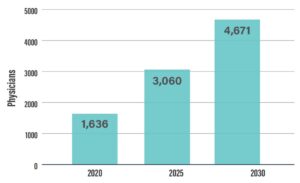By Vitorio Nastasi, Policy Analyst, Reason Foundation; Adjunct Scholar, The James Madison Institute
And Sal Nuzzo, Vice President of Policy
I. Introduction
In Florida, and across the country, there is an impending shortage of physicians. According to the Association of American Medical Colleges (AAMC), a growing, aging population is expected to generate a shortage of between 46,900 and 121,900 physicians by the year 2032.[1] This trend may be particularly problematic in a state like Florida where more than 20 percent of the population is over 65 years old. The Health Resources and Services Administration estimates that Florida already needs an additional 1,636 primary care physicians to address existing shortages.[2] The shortage is projected to grow to over 3,000 primary care physicians by 2025 and as high as 4,671 by 2030.[3],[4]

Many of the challenges faced by our healthcare system are national in nature. For example, private and public forms of health insurance act as third-party payers, distorting the market and insulating consumers from prices. Recent expansions of health insurance coverage under the Affordable Care Act only exacerbate this distortion and place further strains on the healthcare system. As demand for healthcare services outpaces the supply of providers, prices will continue to increase. Fortunately, there are several policy measures that can be pursued at the state level to address provider shortages, expand access, and lower costs for patients. This report examines policy reforms that will enable innovations in the healthcare industry to take hold and help mitigate the growing physician shortage in the Sunshine State.
Telehealth is one of many emerging trends in healthcare with tremendous potential to expand access and achieve cost-reductions. In 2019, the Florida Legislature took significant steps to clear the way for telehealth providers, but telehealth should not be perceived as a panacea for issues in the healthcare industry. The problems of rising costs and shrinking supply can only be addressed through a broad suite of reforms across a range of policy areas. Addressing the growing physician shortage will require Florida to expand the Scope of Practice for non-physician providers, pursue comprehensive licensing reform, eliminate remaining Certificate of Need requirements, and embrace future technological innovation. Taken together, these measures could go a long way toward ensuring adequate access to healthcare in Florida.
Click here to read the full PDF of “Curing the Physician Shortage: State-Level Prescriptions for a National Problem”
[1] Association of American Medical Colleges. (2019) “The Complexities of Physician Supply and Demand: Projections from 2017 to 2032.” Available at https://www.aamc.org/news-insights/press-releases/new-findings-confirm-predictions-physician-shortage
[2] U.S. Department of Health and Human Services, Health Resources and Services Administration, Bureau of Health Workforce. (2019). Designated Health Professional Shortage Areas Statistics: First Quarter of Fiscal Year 2020
Designated HPSA Quarterly Summary.
[3] U.S. Department of Health and Human Services, Health Resources and Services Administration, Bureau of Health Workforce, National Center for Health Workforce Analysis. (2016) “State-Level Projections of Supply and Demand for Primary Care Practitioners: 2013-2025.” Available at https://bhw.hrsa.gov/sites/default/files/bhw/health-workforce-analysis/research/projections/primary-care-state-projections2013-2025.pdf
[4] American Academy of Family Practitioners, Robert Graham Center. (n.d.) “Florida: Projecting Primary Care Physician Workforce.” Available at https://www.graham-center.org/content/dam/rgc/documents/maps-data-tools/state-collections/workforce-projections/Florida.pdf












